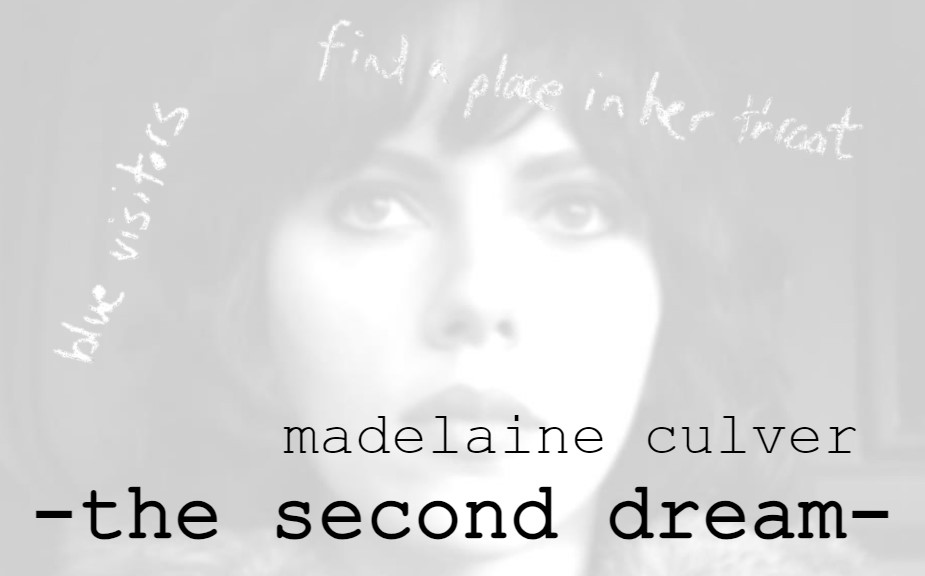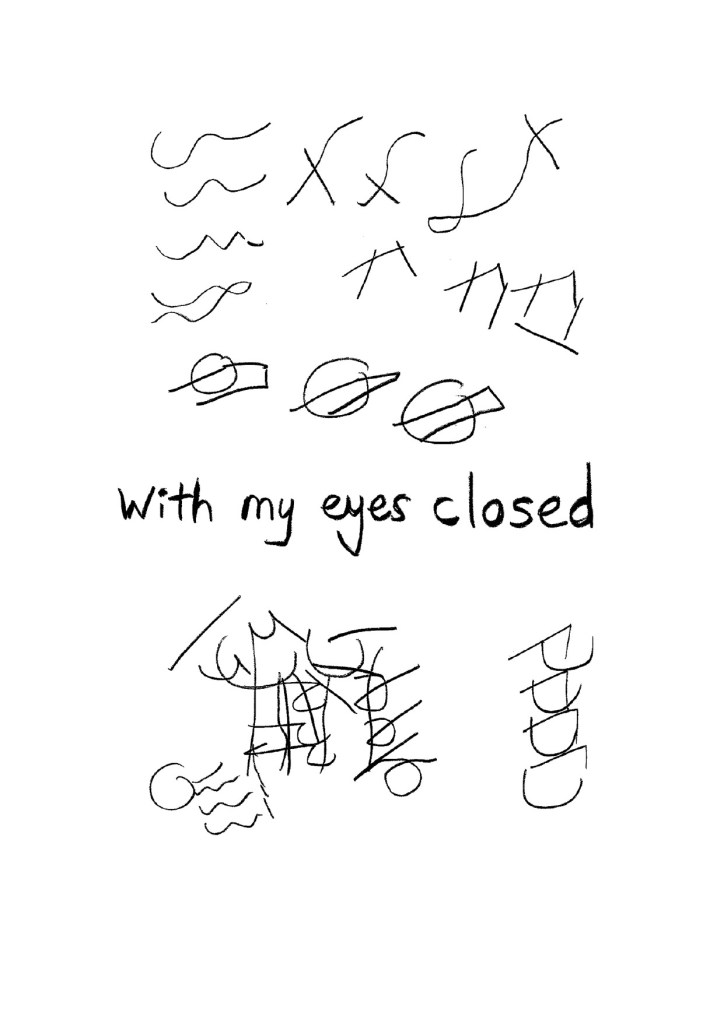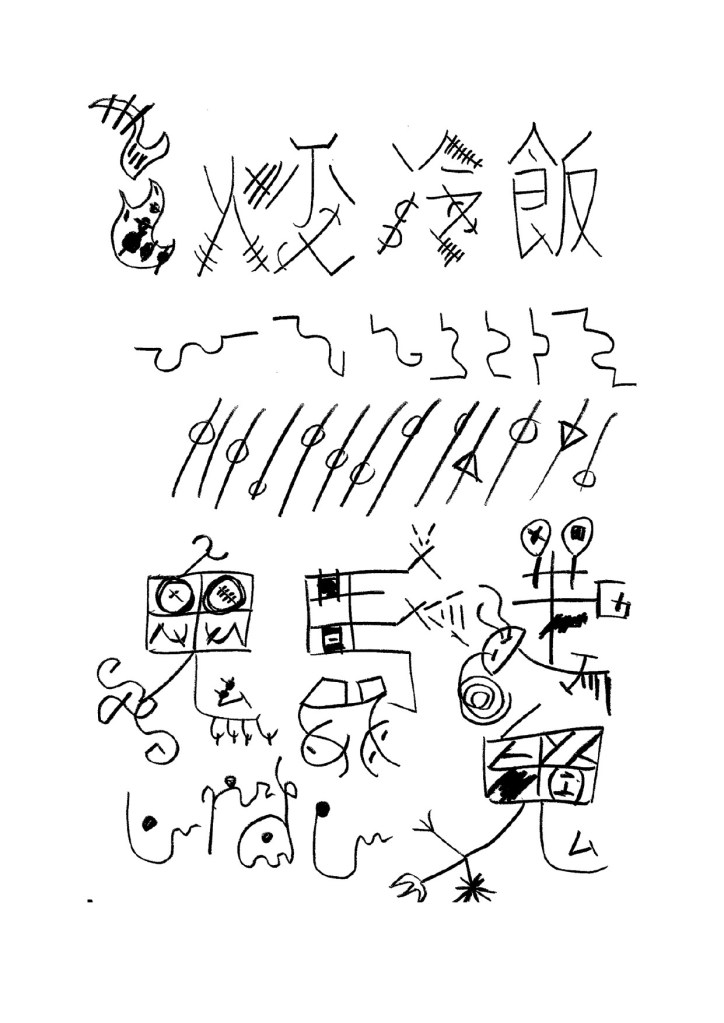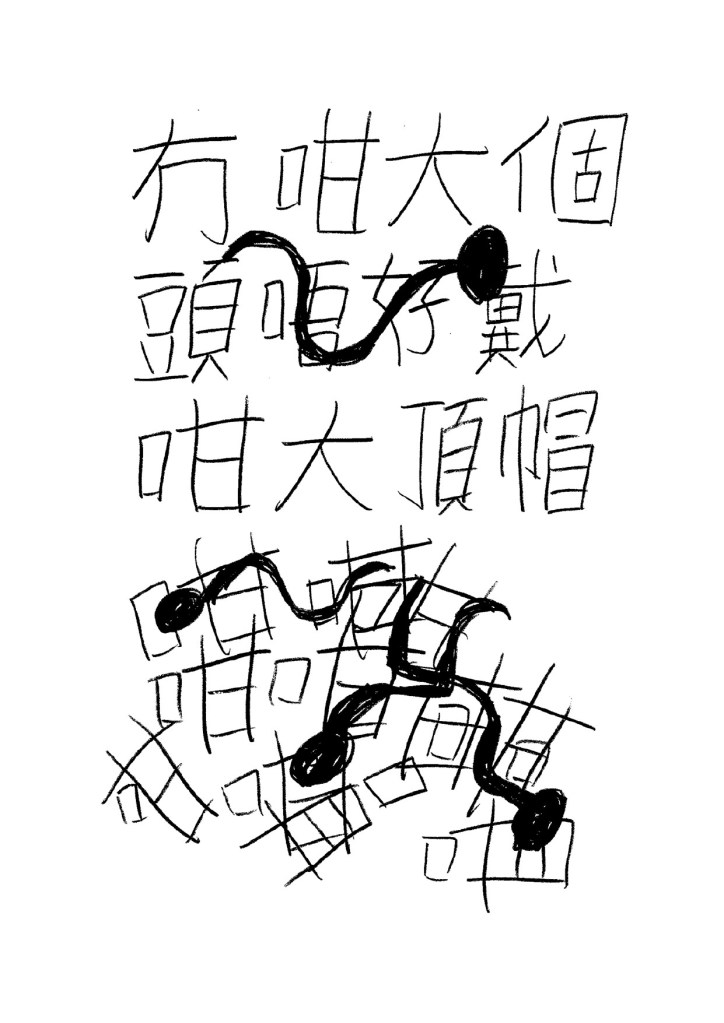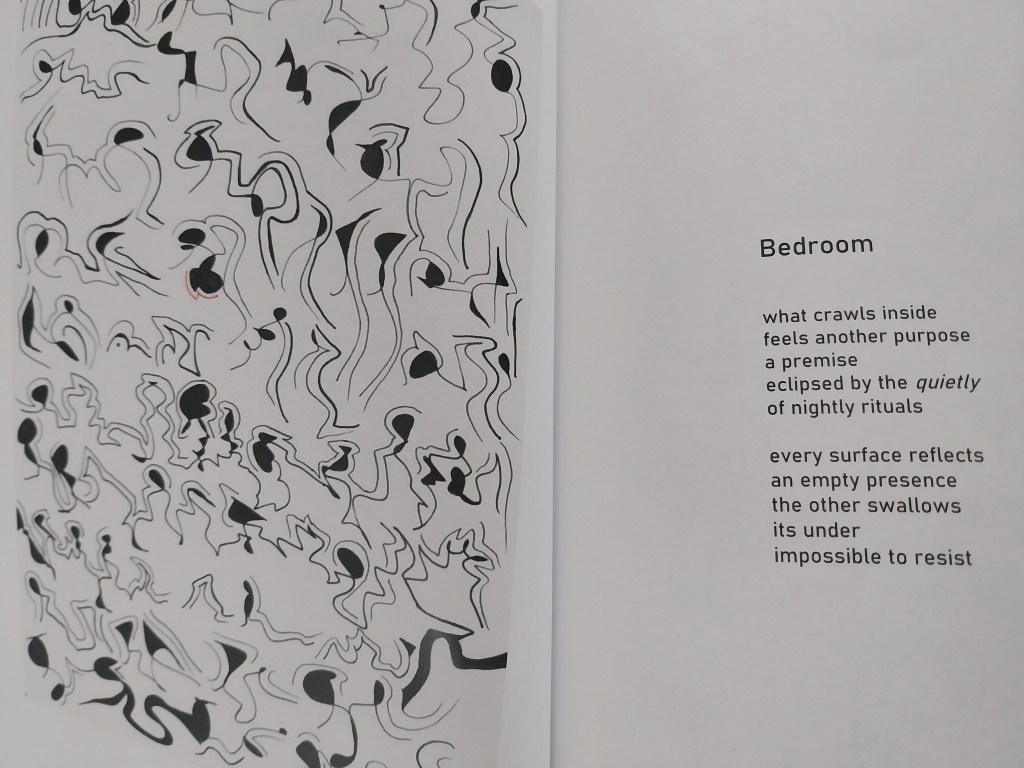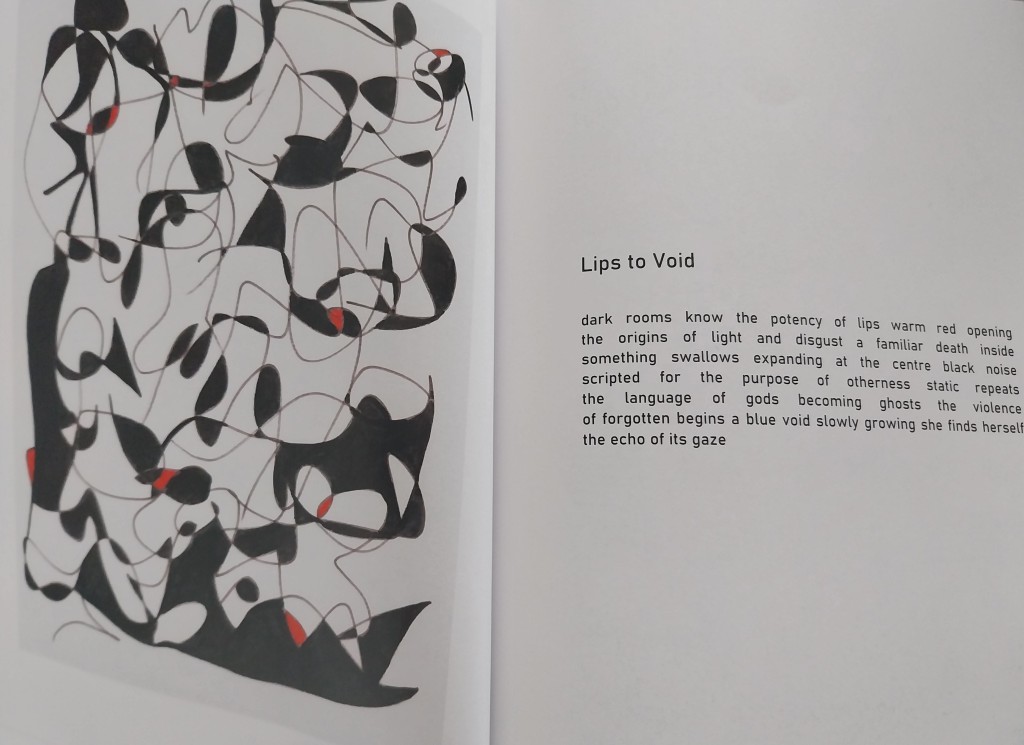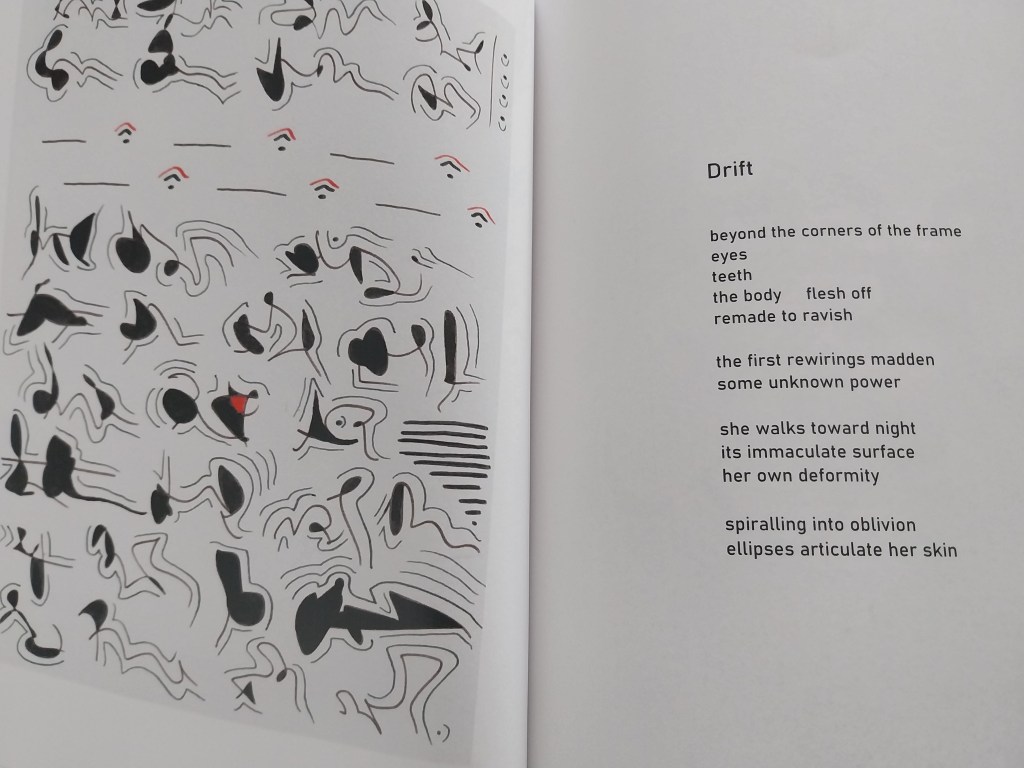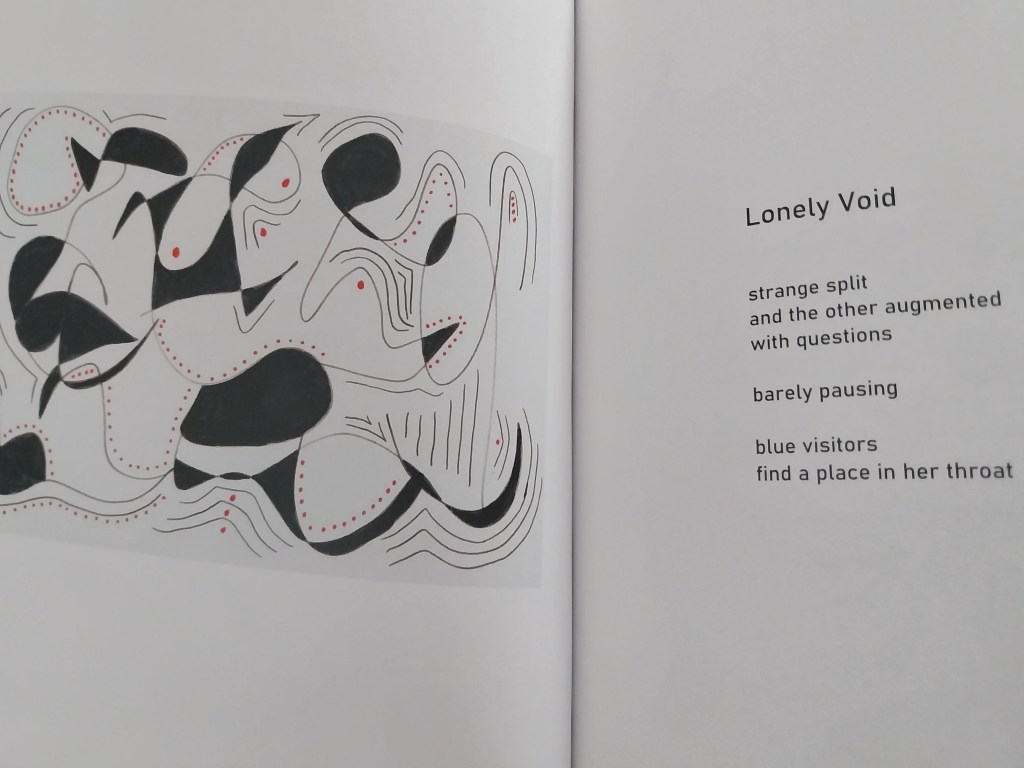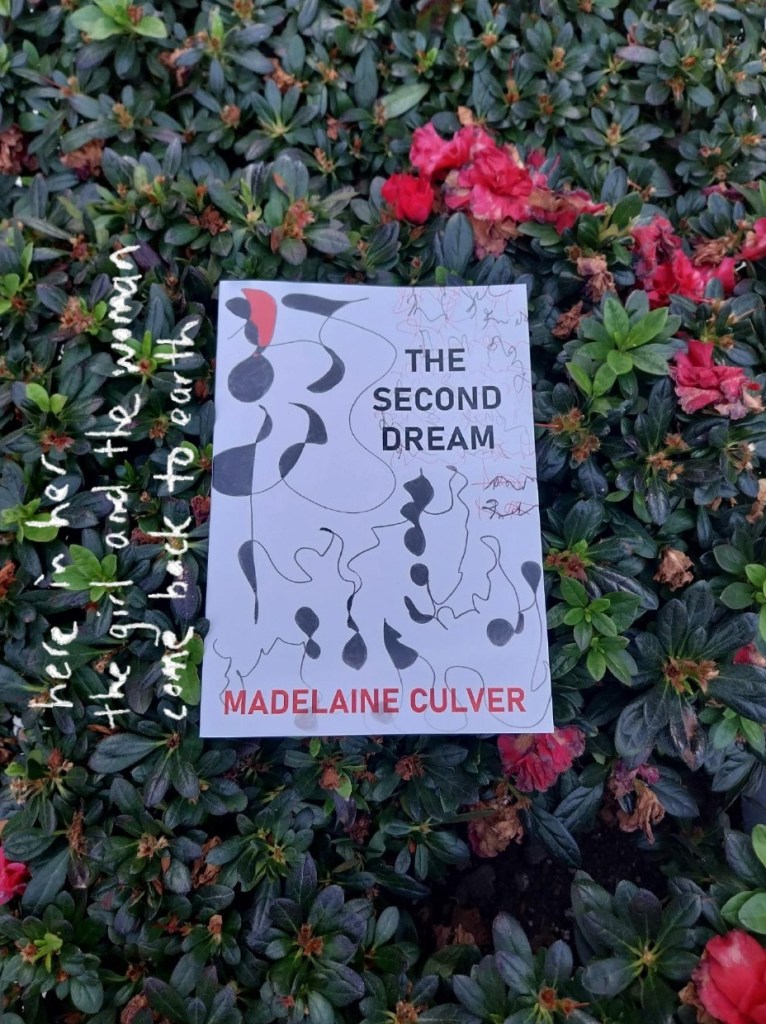+++
Text: The Second Dream
Author: Madelaine Culver
Publisher: Steel Incisors
Plot: The blackness from Under The Skin sublimates out from its Scottish void to investigate the novelette form and something called Asemic writing that looks suspiciously like Arabic.
Subplot: Seduced and abandoned, the First Dream wanders the streets of Nowhere City, getting into fights with homeless people and scribbling Urdu on the subway walls.
Sub-subplot: The Masculine disguises itself as an elderly crone and ventures into the forest with a basket of plastic apples, one of them coated in green shit. But Snow White is not at home that day. She’s in the mines, whistling.
+++
To start with, The Second Dream is an [ekphratic?] response to the watching of the 2013 film, Under the Skin, which I have yet to see. I’ve tried to find it online but all I got was various pornography and a 90’s thing called Alien Agenda: Under the Skin, which I may try and watch at some point, but not now, cos I’m still trying to find the real Under the Skin.
Dailymotion?
+
After more exhaustive searching, I’ve decided to just watch clips on YouTube and a recap by one of those channels that reads the wiki summary of the film out loud like a between-murders sociopath.
I hope it’s enough.
+
+
Beyond the Glazer film, there’s a focus [in The Second Dream] on Asemic Writing, which my brain translated as Assyrian writing for some reason. Or a close cousin of it. Actually, looking at the pages of Asemic writing in this quite slim book, I get reminded of the time I attempted to learn Urdu. It was almost ten years ago now, but I remember the four stages of each letter – infinitive, initial, middle, tail [terminology may be off a bit] – and how beautiful it looked as a total-connected mass on the page.
What is Asemic Writing?
According to wiki, it’s the fusion of text and image that is different from abstract art cos, if you squint, you can still recognise it as text even though it has no semantic meaning.
This seems to fit well with Under the Skin as, if you squint, you can see that Scarlett J looks like a human female yet isn’t that at all.
Does it render language + translation redundant?
Anyone can “see” anything in it.
E.g. most male victims “see” Scarlett J as alluring whereas she stares at her own naked body and sees an Asemic-construct; she’s interpreting her SELF live as the film progresses.
+
I’ve tried a variation of zaum poetry before, and surrealist poetry, and nonsense poetry, and whatever it is I’m doing now on Psycho h – those black scrawl things that must come from somewhere – but Asemic writing is brand new to me.
Apparently, I need to just pick up a pen, close my eyes and start scribbling. Not sure if closing my eyes really alters anything mentally – my psyche is a constantly looping thing, I cannot switch it off or meditate it towards a bucolic, green field – yet that is what I’ve just tried and below is the result [complete with note confirming that I had my eyes closed].
Does that do anything for anyone?
Looks a bit like Arabic to me.
Or ancient Assyrian.
But then, I’m not reacting to anything, while Madelaine was sketching after watching Under the Skin, or watching it as she was sketching, or playing it on loop like Gary and Begotten. I’m not sure of the exact conditions, but it was in her head.
+
I’m not big on research, or structure in essay writing, so here’s the most basic recap of the history of Asemic writing [for you and for me cos I’ll probably forget it later].
Started in 1997, visual poets Tim Gaze + Jim Leftwich used the term Asemic.
The end.
Obviously, the real timeline of the art itself goes back centuries. In the Tang Dynasty, Zhang Xu + drunk monk Huaisu created wild illegible calligraphy [which is kind of interesting as, nowadays written Chinese is kind of like French in the sense that the traditional institutions don’t like anyone fucking with it, even though loads of artists do just that.
At least half of that last part is correct, don’t know for sure about the French/Chinese institutions, just running off what other French/Chinese friends tell me. I’m a bit drunk to be honest. Typing this up, not writing the notes initially. Might edit this part out later.
– end brackets [I almost forgot]]
In the 1920’s, Man Ray [influenced by film dada and all the great pieces over there, including Saint Maud by Madelaine] created a work of wordless writing in his poem ‘Paris, Mai 1924.’ Then Henri Michaux jumped in and did ‘Alphabet’ [1925] + ‘Narration’ [1927].
I’m stopping to close my eyes again, imagining Man Ray on a deserted space station with only a beachball for company. And the beachball does not want to fuck him.
With this in mind, I’ve come up with this, my second Asemic piece of writing.
I think this one is a little busy, but better than the first. If there’s a ‘better’ quality that can be fixed in this kind of thing. I need to think about that a bit more. If there’s no discernible meaning, isn’t it just faux-Arabic [to a non-Arabic speaker – an Arabic speaker might recognise an accidental similarity in the shape and form of the squiggles].
Modern history?
In the 80’s, Chinese artists Xu Bing [A Book From The Sky] + Gu Wenda conjured up fake Chinese ideograms.
Kind of like what I did on one of the Trash F-Log pieces, and what I’ve just done on my next four Asemic writing pieces. I won’t put them up now, but there are Chinese ideograms in there if you squint hard enough.
Also in China, calligraphy-ism. Luo Qi attempted to turn calligraphy into an abstract form. It’s unclear how abstract, or how far you would need to go as Chinese ideograms obviously have a pictorial etymology, and also a denotative meaning for Chinese readers that can be distorted quite a lot before becoming unrecognisable as that original ideogram.
Even I can read some of the skewed graffiti on my neighbourhood walls.
Well, some of it.
If it says ‘die’ or ‘black dog govt.’
+
A thousand words in and no sign of The Second Dream.
I’m getting there.
Under the Skin too.
Even though I haven’t seen it.
[The 12 minute recap video was quite extensive, it’ll be fine].
+
What is beyond Asemic writing?
Nothing.
Nothing is beyond a place that already possesses no fixed co-ordinates, no recognisable language landmarks.
Asemic writing feels/looks controlled?
In The Second Dream, it needs to resemble text to some degree as it is linked thematically to Under The Skin i.e. wrestling with its own form. Or its understanding that there should be a form. That there is a form [body] there to be understood/interpreted.
We still have a body whether it disgusts us or not.
Transhumanism supplements the body, adds metal and computer implants.
Post-humanism turns it inside out [I think – might need to ask Kenji Siratori or David Roden for confirmation on this].
But there is still a body.
Can we ever truly let go and write from a non-body state?
Not if writing is the final act.
With my own stuff, I write with a mix of conscious design + experimentation, but I try to limit the design aspect. I don’t want to know what it means – what I want something to mean – yet abstraction still has its root, is still a delivery service of some type…disguised too much and it becomes what?
To who?
[I can’t put an ‘m’ on that, makes me feel like John Gielgud or Basil Rathbone].
Before I start putting up full page pics of The Second Dream, I wanna deal with Under The Skin, the film I’ve only seen clips of.
Feels important to do this, cos it’s important to the text.
Plot?
Either an alien or Scottish myth preys on men as they or she drift/s aimlessly across Glasgow and then the Highlands.
They lure the men into a black liquid void that sucks out their insides/empties them.
Does Scarlett J consume via this process?
It’s unclear.
There are men on motorbikes monitoring her activities and tidying up after her, so they could be the ones consuming the gore, and the black void could simply be a metaphor for the coldness of the deaths, which are merged with the thwarted potential of the sex-act.
I don’t know.
As usual, I ignore other analysis of related texts and go with my own decomposing brain. Or my brain decomposing the rest of me.
[I learnt in the You With Your Memory Are Dead de-con-struc that decompose can be a transitive verb and I will probably keep using it for a few more months before final overkill].
Does she consume the insides of the men?
Possibly.
But she doesn’t get much joy from it.
If joy has any meaning for her kind.
If she is of a kind.
+
On to The Second Dream then.
Why this title?
Was there a first dream? I made a joke about it at the start, but is there?
Theory: the life and world we are experiencing materially is the first dream, and the second dream is whatever lies beyond it, constructed as a dream cos everything is abstract + abstruse there.
I think it fits pretty well with Under The Skin, if you mark Scarlett J as an interloper from the realm of the second dream, and might fit with this text too.
+
I’ve checked and the top search for The Second Dream is related to something called WarFrame, possibly a video game.
The Second Dream is a Main Quest added in Update 18.0 (2015-12-03), serving as a continuation of Stolen Dreams and Natah. It is the first Cinematic Quest, and yields significant lore on both the Sentients and the Stalker, along with the origin of the Tenno.
I’m guessing this is unconnected.
If it isn’t, I’m in trouble.
+
+
All of the poems in The Second Dream have an adjacent page with Asemic writing [which I assume relates to the poem], except this one.
Why?
Creation is the first act and, like ourselves, we don’t know for sure what preceded it. Therefore, there can be no Asemic writing.
That means Asemic writing is the conscious act of trying to access the unconscious self that may have been present before creation?
god knows.
The poem itself has no punctuation, odd syntax, words that could be linked or not linked to one another.
‘Faultless violence’ ‘hollow’ = Scarlett J?
Once created, violence is inevitable. Cold killing is faultless when there is yet to exist a sense of self. We don’t know why she kills. It’s nothing personal.
+
‘She
at the centre
hollow reverberating
beyond what is
another sign maddening
waits
to be staged’
+
[Ignore the text positioning, WordPress is the devil, it’s easier to put quotes centralised in this way]
It feels like, in a sentence from a completed, ‘integrated to this society and language’ self, this would read as: ‘She, at the centre, hollow, reverberating beyond what is another sign, maddening, waits to be staged.’
The underlying clause would be ‘She waits to be staged,’ with all the stuff in the middle representing her mental state in relation to it.
Yet, in the film, and watching the film, there is a discordant vibe to the opening as limited details are given. Who was Scarlett J before the clothes grab? The white dot that initiates the film? And who is Madelaine while watching it?
That may sound a bit wanky, but it’s important. As with my YWYMAD de-con-struc, I want to know Madelaine’s intentions and level of access while writing these poems. When exactly she wrote them as well. Was it during the film, hours after it had finished, days after, weeks?
I don’t think she’s just reflecting the state of Scarlett J’s character, that seems a little pointless.
She’s reflecting herself through the prism of the character?
The creation point is who she was before the film?
Or who she thought of herself as?
Maybe.
From which co-ordinates/black tent though?
+
I still have the SELF & OTHER book leftover from the last de-con-struc, and I’m tempted to drag it in here as it might be connective.
There’s also the Simone De Beauvoir book I got from the library the other week.
And Valis / Phil K Dick.
All three seem related in some way, or could be pressganged into being so.
Maybe later.
+
+
I could be wrong, but this poem feels like it’s in dialogue with the mirror scene in the film, where Scarlett J examines the body she’s caught herself in.
Both her and Madelaine feeling unsure in their own skin? Not necessarily uncomfortable, but detached, distant maybe?
+
‘She doesn’t quite get the idea
Of strangeness
Its camera gaze
Its script
The home of woman
Or not.’
+
She [Madelaine or Scarlett] doesn’t understand the idea that she herself is strange.
Every concept is alien.
Making sense of the body, to understand the biological aspects/functions of each part…but what about the social, the intimate, the historical?
I’m probably about to lose myself in a loop of hypocrisy, but the female form, historically, has led to great art + great suffering, both of which were beyond the control of the body’s occupier [the woman]. Both were something done to them, the art and the suffering. Even female artists painting the female form, is it something done to themselves due to the fact that they exist in a patriarchy?
There is more likely to be introspection/interrogation in the case of female artists, simply cos they do not see themselves as the other, whereas the male gaze typically ignores the female perspective altogether. Or it exists only in relation to their own. Subservience to their own?
Some male authors/artists try to get around this by writing themselves with a female body. I’ve done this in a few novels, basically put my entire psyche inside a woman called Daniella. Don’t know why I landed on that name. I’ve never met anyone distinctive called Daniella. But she exists, more as a character who happens to be a woman than a woman character. If that makes sense.
The writer and director of Under The Skin were men.
Can men interrogate themselves this way, through the female form?
Is Scarlett J their receptacle for this process?
[Receptacle sounds bad but does match the theme of the film i.e. she’s not a woman, the body is literally not hers, yet, socially, she is a woman and is forced to function that way and, gradually, comes to understand what that functioning means]
Repeat question: can men interrogate themselves this way?
Maybe.
There could be some crossover, within different contexts. I think.
e.g. a woman entering a room of men, even if it’s a party = a man entering a prison full of larger men.
That could provoke a synonymous feeling.
But it’s depressing as it forces in a gay prison sex stereotype. A gay stereotype in general, actually.
I don’t know.
It’s the dormant threat of sexual violence that I’m trying to knit together here. Can a man truly feel that?
Scarlett J can’t, at first. But then, by the end of the film, when she’s partially acclimatised to the female form, she is forced to understand it through the actions of a pervy logger.
That is the threat right there.
Forced into the psyche cos of the skin-suit she’s under.
+
+
It’s funny, looking at the Asemic writing on this page, it doesn’t just resemble Arabic, it also looks like a hybrid mix of black sperm and a crawling foetus.
And it’s dominating the page.
The text opposite matches it to some degree.
Something crawling inside.
The bedroom is a private, intimate space.
This poem violates that, makes it sinister, abject, creepy.
+
‘What crawls inside
Feels another purpose
A premise
Eclipsed by the quietly
Of nightly rituals.’
+
Sex is rendered as an intrusion from beyond, from a sinister other.
Could be referring to Scarlett J and her murders, or sex in general.
But she doesn’t have sex with them, she hypnotises them, settles them inside the black swimming pool.
Is there a split in her psyche? The nightly rituals remain the primary [passive] activity, but inside there is something else investigating a premise.
I’m dwelling on the film too much.
How does this relate to Madelaine, to the inner self?
Same way it relates to all of us. A detachment from things we’ve done thousands of times before [nightly rituals], yet we can’t stop doing them as they feel familiar, comfortable.
Is that it?
I don’t know, it’s hard to write all this out, the film can place your brain into so many different layers, a closed loop of ‘she’s a woman, but she’s not a woman, the men see her that way, she functions as a predator, but she’s not a predator, she’s surviving in some way, she has to do this, but she doesn’t want to do this, she wants to eat cake, she wants to feel connected to the skin she inhabits at this current time, but she’s not a woman, she’s an Other who looks like a woman, an attractive woman, but that doesn’t mean anything to her cos she’s not really a woman etc.’
You can’t just land on one perspective and stay there, investigating, it won’t allow you to do that.
Neither do the poems.
The language used is off-kilter grammatically, often takes you down what you think is a long sentence broken up into short lines and then ditches you right near the end to go in a completely different direction. Just like the ‘another sign maddening’ section in the first poem.
Madelaine is embracing abstraction within the film’s abstraction to confuse us [and herself] into investigating ourselves more, deeper, smaller etc.
That’s what it feels like.
+
+
Asemic writing has red parts that could be lips?
The black parts are larger too…they’re growing?
Do the male victims linger in the mind of Scarlett J? Is that what is affecting her [towards a premise]?
+
‘begins a blue voids slowly growing she finds herself
The echo of its gaze.’
+
The victims have formed a blue void and are taking over, reducing her to an echo?
I’m trying to associate this poem with a scene in the film, but I haven’t seen the film, only the YouTube recap, so I’m struggling.
Maybe the bit where we see one of the victims emptied inside the black void?
Yet that doesn’t seem to affect her too much afterwards.
She connects more to the guy with facial tumours. And spares his life due to that connection. Which could be a parting point from her nymph-predator role as it provokes the motorcycle guy into calling his two mates and hunting her down.
That whole aspect of the film is a bit odd.
Are they aliens too?
+
+
Are the black bits her equivalent of a heartbeat? Or the map of her brain?
Is there a difference?
In metaphor, the heart is the emotional core, but in reality it’s the brain, so the question is…something I’ve forgotten…just slipped out of my head, can’t remember it at all.
+
‘the first rewirings madden
Some unknown power’
+
This is the second time ‘madden’ has been used.
Sounds quite similar to Madelaine.
But is probably just ‘to make something mad.’
Who is maddening/being maddened? Who is the unknown power?
A newly constructed self, or the motorbike guys?
‘Rewirings’ could be a figurative term for the process of killing the men to revitalise her own body, like a vampire.
I think I asked the same thing earlier, but is she feeding on them?
Whatever she’s up to, it’s still a cold, estranging experience. Definitely not maddening though. That must be her state.
How metaphorical is this exactly?
Assuming Madelaine is not an alien serial killer targeting skinny Scottish guys, is killing a symbol for the sex-act? An alternative to it [as she doesn’t actually have sex with anyone]?
Is it describing the periphery between girlhood and womanhood?
Perhaps, although that seems a bit basic.
Feels more like it’s threaded to the self/psyche. Phenomenology hits everyone, male and female. Sartre struggled with a bench and that’s just a bench, an inanimate object. How do you even begin to comprehend the body-mind complex?
I remember writing something in another de-con-struc, probably lifted from that SELF & OTHER book I’ve recently glued myself to, about the mind needing a body to function properly. The idea being, I suppose, that they are wedded together in relative harmony.
Yet what if they’re not?
Some people might look at it as a vessel of horror, or vassal if you’re an alien hitch-hiker backed by a gang of motorbike guys.
You can reach this point, estrangement from the body, simply by thinking about it too much, just like Sartre and his bench. Reducing it beyond its biological functions, trying to reconcile it with the mind on an alternative level.
Mind + body as strangers/mutual antagonists. Or a counter point of confusion.
But the body just is.
Isn’t it?
+
‘She walks toward night
its immaculate surface
her own deformity.’
+
Scarlett J is akin to a nymph-god, she has power over men and even has 3 bikers to clean up after her. But at the end she is assaulted and then burnt to death by a man. There was no power after all. She was just drifting until a man came along and killed her. Scratched off her skin. It is an alien dressed as a human woman who has become something new under the skin yet that skin is alien and can only ever be that in the mind of a sleazy logger.
+
+
Blue void, blue visitors.
What does blue represent?
‘strange split’
The mind and the body?
Strange to who?
There is no blue in the Asemic writing, only black and red, which are the colours of her lips and the void she sucks her victims into.
Blue visitors finding a place in her throat could mean two things [probably more than that, my brain is a paddling pool]:
i] the blue visitors are preventing her from breathing.
ii] they are helping her to speak/breathe.
From the perspective of ‘becoming’, the latter one is definitely more uplifting, but a film where the main character that we have come to associate with [for good and bad] is burnt to ashes does not seem interested in that feeling.
Yet Scarlett J did grow more human before death.
In that she was confused about her own identity/existence.
Maybe the blue visitors were doing both, preventing breath and assisting it?
Not sure if that makes sense.
Just had a thought: the guy who murders her is a commercial logger, a destroyer of the planet, and now a destroyer of another life form too. All cos she looked different and wouldn’t fuck him.
The black bits of Asemic writing resemble giant sperm now, without a tail, barely contained inside the page.
+
I’m a bit stuck in terms of how much of the book to show/investigate. There are ten poems in total and I’ve already done six. If I show all of them, others might not go and buy the book.
I think I’ll skip a couple.
[Having read those couple, I’ll just say that it seems like they’re focused on the ‘mirror scene’ and perhaps the breaking down of the male victim inside the black void. The feel is that Scarlett J [and Madelaine] is operating between the events in a state of ‘searching’ + ‘emptying’ – the two are forced together jarringly, which I appreciate].
+
Actually, this might be a good time to briefly wheel in Simone De Beauvoir, specifically her lines on the feminine as second sex that I’ve just plucked out of the only book of hers on the shelf at the local library.
‘One is not born…described as feminine.’
And
‘Humanity is male…she is the Other.’
I think she is stating the common view of society historically in that last line, not endorsing it. The first line pretty much confirms that.
And from both lines, my mind will now unspool the following:
There is no second sex, no Hegelian Unity of Opposites here. No Venus/Mars dualism. Men and women are not in relation to each other but in collision, a maddening of fluidic forms that don’t even know what they are, or to what degree they are that thing. The self is struggling to situate itself in a void of other selves that, if as complex as it suspects itself to be, is terrifying/uplifting.
How true any of that is, you decide.
[Don’t even know if I used Hegel right].
+
Feel like I’ve used De Beauvoir there a bit, exploited her.
Two quoted lines then done.
Am I the motorbike guy?
+
The motorbike guy is a blank, I refuse to be him.
I am Scarlett J.
The part of her beyond the body, trying to make sense of it.
+
+
This one may be dealing with the infamous beach scene. The red and black lines at the end represent the death line?
Or is it from bottom to top?
She starts blank, has eruptions in feeling, then returns to relative blankness at the top?
Doesn’t quite match the scene though.
Scarlett J watches impassively throughout.
There are no eruptions [on the skin].
+
It’s interesting that the beach scene appears to have no effect on the emotional state of Scarlett J as it’s such a harrowing event, the drowning of two people [and a dog] and the abandonment of a crying baby.
But then she is not attached to any of them.
They are distant figures in the sea.
Why would she care?
Emotional contagion vs emotional sharing.
It’s back from the last de-con-struc, and just as relevant, I think. Both the poems in The Second Dream and the Scarlett J character are vague, in ontology and other ‘-ologys’ too.
Scarlett J is not a woman in the film. Just like my alien-witch character in Castle Damijana, she is wearing the skin of one. What is their foundational core?
Was it socially constructed back on their home planet? What is her purpose on Earth?
It feels like they have both blended in [language, body movements] and detached themselves. They can speak and interact in English yet they feel apathetic when two people drown.
The poems mirror this interzone, with phrases forced together against their normal meanings e.g. ‘formless void separating into a language of mirrors.’
Void = empty [connotative meaning]
Language = a construct with attached meanings so we can argue with each other about old Trek vs Nu Trek
Mirrors = tool to give superficial reflection + make me look tired
Hate to overuse the word inversions, but they’re in there too e.g. ‘begins a blue void, slowly growing she finds herself the echo of its gaze.’
The void is gazing and produces an echo of that gaze that has become a slowly growing SHE, which means life has come from a reflection of other life that should have no life cos it’s empty.
If I relate the poems to Madelaine’s thoughts/mind, what does that give me?
That she FEELS Scarlett J’s character as the echo of the male/social gaze that is itself empty in the sense that the SELF contained within or existent beyond the need to fuck is unmoored and unknowable, and when those men are digested inside the black void, do they finally comprehend that?
But they are not burnt to death.
Isn’t that worse?
Which aspect of Scarlett J does Madelaine connect to?
What does she wish her to achieve, if anything?
Emotional sharing is problematic as she doesn’t have the reference points to view humans as autonomous others.
Does she?
For most of the film, no.
It’s tough to write about, I have to keep re-defining her character…their character…as alien/nascent woman/nascent human/sociopath/mythical nymph cos the journey she goes on in the film is an oscillating one. I mean, there is no stark point where I can say, right, she won’t kill any more men now. She doesn’t in the last third though. Maybe her hypnotism powers aren’t working due to a constant state of confusion. I don’t know. Who is she at the end? Who was she at the beginning?
I also keep switching between SHE and THEY in this piece, which proves the point more.
Don’t think I’ve used IT yet.
SHE’S/THEY’RE not an IT.
But can they experience emotional sharing?
The man with facial tumours is let go, and, from that point on, she does not suck anyone else into the black void.
Why not?
Emotional contagion?
She examines her body in the mirror, appears curious about it.
But it doesn’t feel like emotional sharing either.
Something in between?
It’s been a week between notes, so there may lie a bit of repetition ahead. It’s okay, some of the sentences will be in a different order. And I generally view repetition as a good thing, a revealing thing sometimes. In experimental writing. Not general movie sludge from Hollywood.
+
Relating 100% to a fictional character is a dead end. Instead, which specific aspects of Scarlett J does Madelaine relate to/interrogate?
[or ‘investigate’? ‘Interrogate’ always sounds a bit Stasi/CIA to me].
Obviously she’s not a sociopathic alien with nebulous background cruising the Scottish Highlands. But she may still have a nebulous background. I may have too. I do. Can we trust our memories? Sometimes I remember getting punched in a club in Liverpool and other times it’s my friend getting punched and I’m giving him a tissue for his bleeding nose. I genuinely can’t determine which one is true.
And when does the background begin?
If you’re a psychic nomad, it’s starts from your last iteration. But how firm is that? Based on what ingredients? If you move around a lot, live in different countries, speak other languages, your background shifts to another iteration.
These poems place Madelaine in the film and between the gaps of it.
She’s following the spirit of the thing, the confusion/curiosity/disgust.
But how to ground that?
The ‘nebulous background’ part does make it difficult. The viewer can’t know who Scarlett J started as. Who I/We/Madelaine started as. A white dot?
Can’t be nothing.
Can it?
I keep coming back to De Beauvoir.
‘The world was a masculine world.’
and
‘Humanity is male…she is the Other.’
Scarlett J shows no fear of this in the film, she functions as a blank predator, the concept of masculine world or patriarchy does not exist in her mind, yet, ultimately, when she starts to feel the truth of this context, the skin of the woman she inhabits, she is quickly murdered by a man.
Bad timing or symbolic?
This isn’t Alien Agenda: Under The Skin, so I’m going with the latter.
Madelaine is [theoretically, in my masculine head] coming from the opposite direction. She knows it was/is a masculine world and is forced to explore/investigate her SELF against that context. Or from inside that context [previously like an oubliette, and now, a slightly larger oubliette with couch, computer and female prison guards parked next to the male gorillas]. She is trying to get to the point where she can blankly mesmerise a guy into a black void.
That doesn’t make sense either.
I’m a bit confused [of my own making].
Edit: Scarlett J has no concept of the masculine world but still operates in relation to it i.e. she feeds on men. And is on the leash of the motorbike guy. Who probably isn’t a man but an alien. In the skin of a man. Controlling the predatory habits of a skin-woman who doesn’t seem particularly invested in preying on anyone. Once again, it’s a patriarchy, only skewed a little.
There is no third, fourth, fifth, seventeenth way.
Perhaps that’s why the poems exist as they are, forced collisions of the empty + constructed, inversions echoing inversions [don’t try to picture this, it hurts]…cos there’s no easy to mark down end point to this, no final SELF or IDENTITY.
When her human face is peeled off at the climax, Scarlett J looks at it [as alien] as if she can’t quite understand that it was something of her. And now that it’s off, is there a reflection [before the logger returns] of that former state?
+
Under the skin, the alien is black-skinned, as black as it gets.
Is there a racial element to this?
Colour-wise, it matches the black void, which implies emptiness and a kind of synchronicity, but it could also be about immigrants struggling to adapt to/survive in another culture, especially a place like the UK, where you might soon find yourself dumped on the next flight to Rwanda.
I’ll have to watch the YouTube recap video again, see if the other parts of the film line up with this analysis. Doesn’t feel like they do. I mean, immigrants don’t usually lure men into derelict houses. And they’re not starting as a white dot when they come in.
Right?
+
+
‘formless void separating
into a language of mirrors.’
+
Contradictions that don’t make sense e.g. how does a formless void separate, what is a language of mirrors, wouldn’t they just reflect constantly the original speech? Would it be distorted via entropy?
Something magical is happening.
‘the artistry of alien
doubling as destruction‘
Scarlett J has evolved internally [under the skin] and is destroyed apart from it as she is now seen as a destroyer by the male destroyer [logger guy], even though she sees herself still with curious bemusement.
There is also art to her killing aesthetic, metaphor or not. Feels original.
‘everything inside
riddled with new gods‘
god as a human creation, lower case ‘g’.
Each new god is an individual deviation?
+
Just tried the first ten minutes of Alien Agenda: Under The Skin.
It’s a lot worse than I expected.
No production values.
Shit acting.
Very masculine.
I’m rooting for the greys.
+++
The Second Dream is a slight and pretty and challenging book that should be available here
